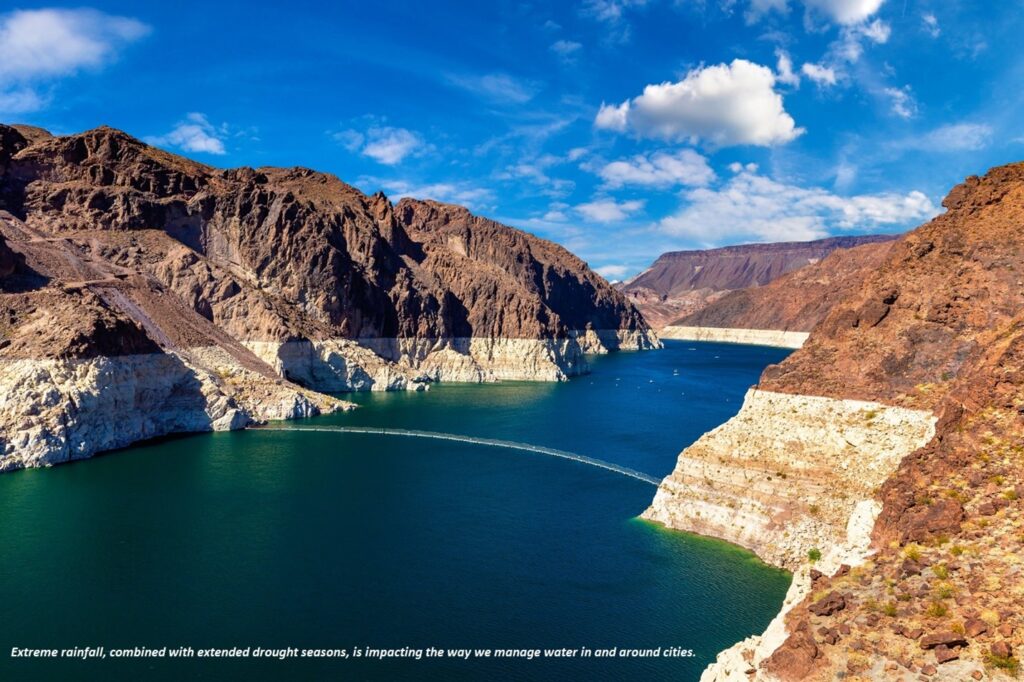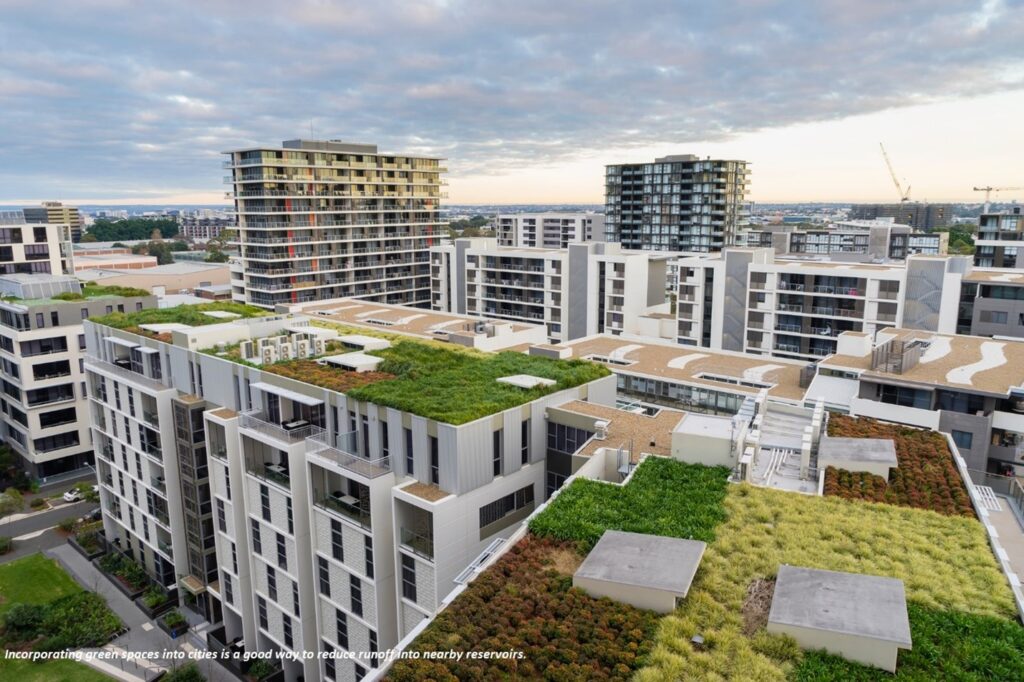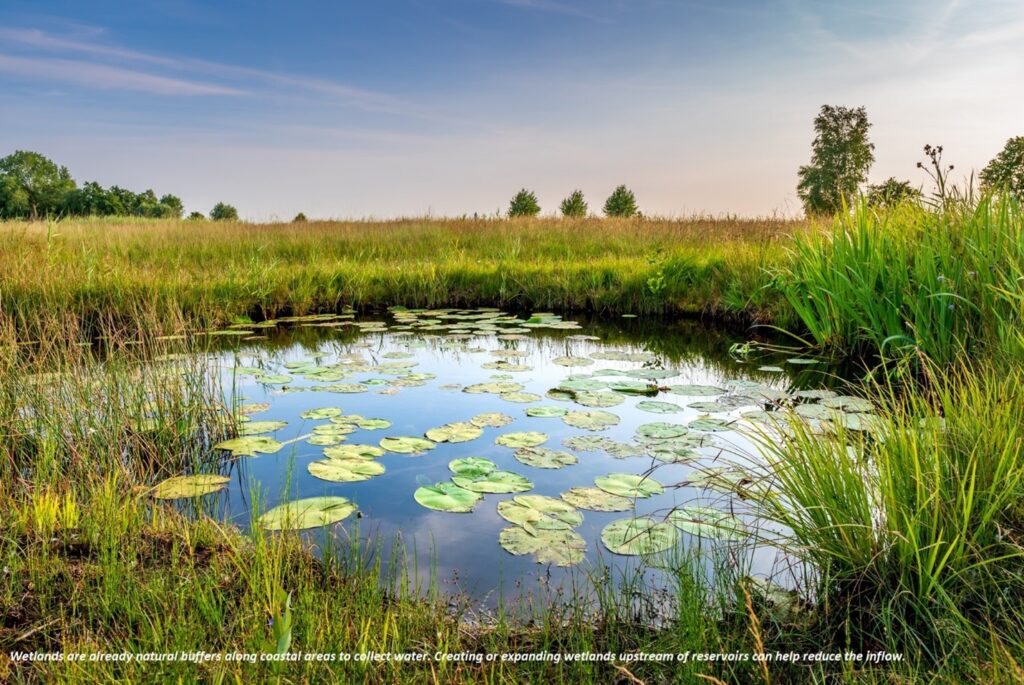Rouzbeh Berton, PE (Hydrologist, Stantec)
Carmen Bernedo-Sanchez, PE (Hydrologist, Stantec)

(Hydrologist, Stantec)

Though dams have existed for centuries, many large dams were built throughout the United States as early as 100 years ago. Initially, dams mainly stored excess water for later use—typically during a drier part of the year. However, dams have grown to become multipurpose infrastructures supporting hydropower generation, drinking water demands, and industrial water supply. Now, we are highly dependent on our dams and the water they store.
Scientists caution that climate change, and the increasing number of extreme weather events, will significantly impact our water resources. In recent years, weather patterns have changed so much, that the rainfall is not as predicable (e.g., Salas et al., 2020; Xu et al., 2022). Many places are getting most of their annual rainfall in a few intense events, while the rest of the year is dry (e.g., Ingram, 2016). Instead of slowly gaining and releasing water throughout the year, in some areas, reservoirs are seeing an influx of a year’s worth of rainfall all at once (e.g., Fleming & Weber, 2012; Maddu et al., 2022; Naz et al., 2018; Yu et al., 2014). This change might not seem significant, but existing dams were simply not designed to accommodate storm water like that.
Imagine a dam is almost full, and a major rainstorm happens. If the dam fills more, it could overflow, and dam safety would be a concern. Likely, you would open the dam gates to release some of the extra water. This prevents water from spilling over the top and prevents the dam from failing entirely. But, if you open the gates, you are losing water. Then, what happens during the dry months?
There are many stakeholders who can contribute to a sustainable watershed. Let us take a closer look at some potential solutions for managing water in a time when precipitation patterns are changing. We can design for excess water, store as much water as possible, and be responsible water stewards.

Designing for Excess Water
This is where urban planners step up—by planning how the city fits into the watershed and how water moves in and around the city. The closer buildings, parking lots, and asphalt roads are to the reservoir inlet, the more quickly large amounts of runoff will enter the reservoir. When impervious surfaces—like concrete and asphalt—are evenly distributed across a watershed, instead of being concentrated in specific locations, it slows down the movement of water (e.g., Ariano & Oswald, 2022; de la Cretaz & Barten, 2007; Roodsari & Chandler, 2017). This concept allows for sustainable development while mitigating the excess flow and delaying the amount of water entering the reservoir (e.g., Liu et al., 2022; R et al., 2020; Wang et al., 2021).
In addition to planning where major developments are built in relation to the reservoir, green spaces within a city are also important. In a dense cityscape, think of green spaces like small sponges. The vegetation can soak up some of the water where it slowly drains into the groundwater system, instead of running off as stormwater and entering a reservoir.
Some urban areas even plan for water collection in and on areas that typically would have just been a source of runoff water. For example, landscape architects can incorporate water-absorbing green roofs where appropriate. Some locations that are prone to flooding might want to consider porous asphalt, where water slowly seeps through roads and parking lots instead of running off or pooling up.
Lastly, from a planning perspective, accounting for how the city will grow can lessen flood consequences. Planners can limit urban expansion to areas outside of potential flooding areas. Landscape architects working together with engineering designers can create resilient watersheds. This will help minimize the impact of climate change to our reservoirs.

Maximizing Water Storage
Sometimes, dam owners can raise the height of the dam to accommodate for more intense rainfall. Though, this solution is not always a viable option. As such, we should think about managing the water before it enters the reservoir. Upstream management measures can be innovative and cost-effective. For instance, several detention ponds can be built to temporarily store the incoming water and gradually release it to reduce the pressure on the main reservoir during an extreme event. Appropriate measures can vary from one watershed to another, but ponds might be a simple and cost-effective solution.
While detention ponds offer a good potential solution, there are also two key drawbacks that make them a less-attractive option. First, dam owners often do not own the upstream lands in the watershed, so trying to build a dam and manage water on someone else’s land might not be possible. Second, from a risk perspective, adding upstream detention ponds increase the risk downstream. If a smaller upstream dam failed, it would release that water all at once, adding greater strain on the main reservoir dam.
If building a pond or additional reservoir is not feasible, there could be a middle-ground approach of reclaiming or expanding wetlands. A wetland area can provide a natural buffer to soak up excess water upstream of a reservoir. Wetlands also bypass the two major concerns of the temporary detention ponds. Wetlands may be easier to get permission to create or expand, and there is less risk since there are no additional dams to monitor.

Responsible Water Stewardship and Applying Ancestral Lessons
With weather forecasting, we can all be aware of rain patterns, and can even be notified not to water our lawns and outdoor plants before an extreme rainfall event. Some sprinkler systems run from a timer and will go at the same time every day even if it is raining! Rainwater that is absorbed into your yard recharges our groundwater system instead of flowing directly into a reservoir.
Some of the most sustainable and effective measures are not necessarily the most high-tech. Humans have been managing water for centuries, adopting effective means of storing water to survive droughts, even in arid climates. Community members can contribute to effective water management by understanding and applying lessons learned from our ancestral past. Do not discount your role in managing our limited water resources; we all play a part!
References
Ariano, S. S., & Oswald, C. J. (2022). Broad scale assessment of key drivers of streamflow generation in urban and urbanizing rivers. Hydrological Processes, 36(4), e14579. https://doi.org/https://doi.org/10.1002/hyp.14579
de la Cretaz, A. L., & Barten, P. K. (2007). Land Use Effects on Streamflow and Water Quality in the Northeastern United States (0 ed.). CRC Press. https://doi.org/10.1201/9781420008722
Fleming, S. W., & Weber, F. A. (2012). Detection of long-term change in hydroelectric reservoir inflows: Bridging theory and practise. Journal of Hydrology, 470–471, 36–54. https://doi.org/10.1016/j.jhydrol.2012.08.008
Ingram, W. (2016). Extreme precipitation: Increases all round. Nature Clim. Change, 6(5), 443–444. http://dx.doi.org/10.1038/nclimate2966
Liu, W., Qian, Y., Yao, L., Feng, Q., Engel, B. A., Chen, W., & Yu, T. (2022). Identifying city-scale potential and priority areas for retrofitting green roofs and assessing their runoff reduction effectiveness in urban functional zones. Journal of Cleaner Production, 332, 130064. https://doi.org/https://doi.org/10.1016/j.jclepro.2021.130064
Maddu, R., Pradhan, I., Ahmadisharaf, E., Singh, S. K., & Shaik, R. (2022). Short-range reservoir inflow forecasting using hydrological and large-scale atmospheric circulation information. Journal of Hydrology, 612, 128153. https://doi.org/10.1016/j.jhydrol.2022.128153
Naz, B. S., Kao, S.-C., Ashfaq, M., Gao, H., Rastogi, D., & Gangrade, S. (2018). Effects of climate change on streamflow extremes and implications for reservoir inflow in the United States. Journal of Hydrology, 556, 359–370. https://doi.org/10.1016/j.jhydrol.2017.11.027
R, M. K., L, H. S., Jia, L., Trevor, H., & Shawn, H. J. M. (2020). Spatial Configurations of Land Cover Influence Flood Regulation Ecosystem Services. Journal of Water Resources Planning and Management, 146(11), 04020082. https://doi.org/10.1061/(ASCE)WR.1943-5452.0001294
Roodsari, B. K., & Chandler, D. G. (2017). Distribution of surface imperviousness in small urban catchments predicts runoff peak flows and stream flashiness. Hydrological Processes, 31(17), 2990–3002. https://doi.org/10.1002/hyp.11230
Salas, J. D., Anderson, M. L., Papalexiou, S. M., & Frances, F. (2020). PMP and Climate Variability and Change: A Review. Journal of Hydrologic Engineering, 25(12), 3120002. https://doi.org/10.1061/(ASCE)HE.1943-5584.0002003
Wang, Y., Zhang, X., Xu, J., Liang, C., She, D., & Xiao, Y. (2021). Evaluating effects of urban imperviousness connectivity on runoff with consideration of receiving pervious area properties. Urban Water Journal, 18(8), 598–607. https://doi.org/10.1080/1573062X.2021.1918182
Xu, Z., Chang, A., & di Vittorio, A. (2022). Evaluating and projecting of climate extremes using a variable-resolution global climate model (VR-CESM). Weather and Climate Extremes, 38, 100496. https://doi.org/https://doi.org/10.1016/j.wace.2022.100496
Yu, P.-S., Yang, T.-C., Kuo, C.-M., Chou, J.-C., & Tseng, H.-W. (2014). Climate change impacts on reservoir inflows and subsequent hydroelectric power generation for cascaded hydropower plants. Hydrological Sciences Journal, 59(6), 1196–1212. https://doi.org/10.1080/02626667.2014.912035

No comment yet, add your voice below!